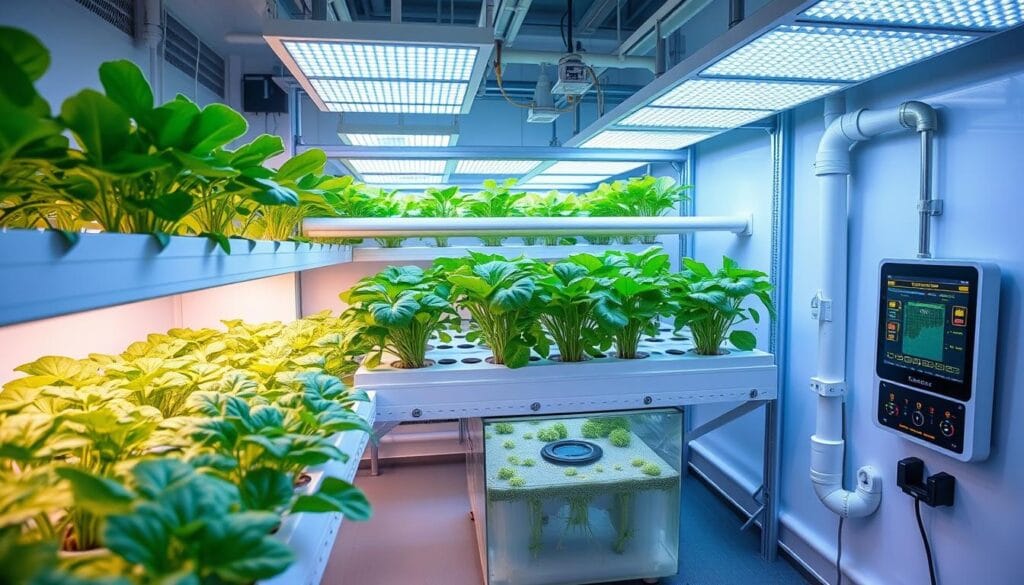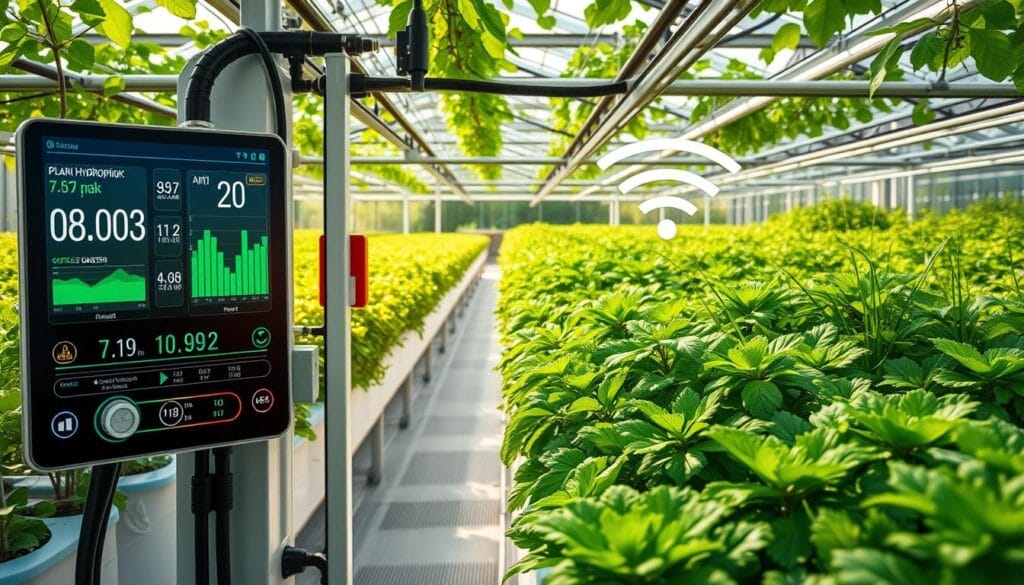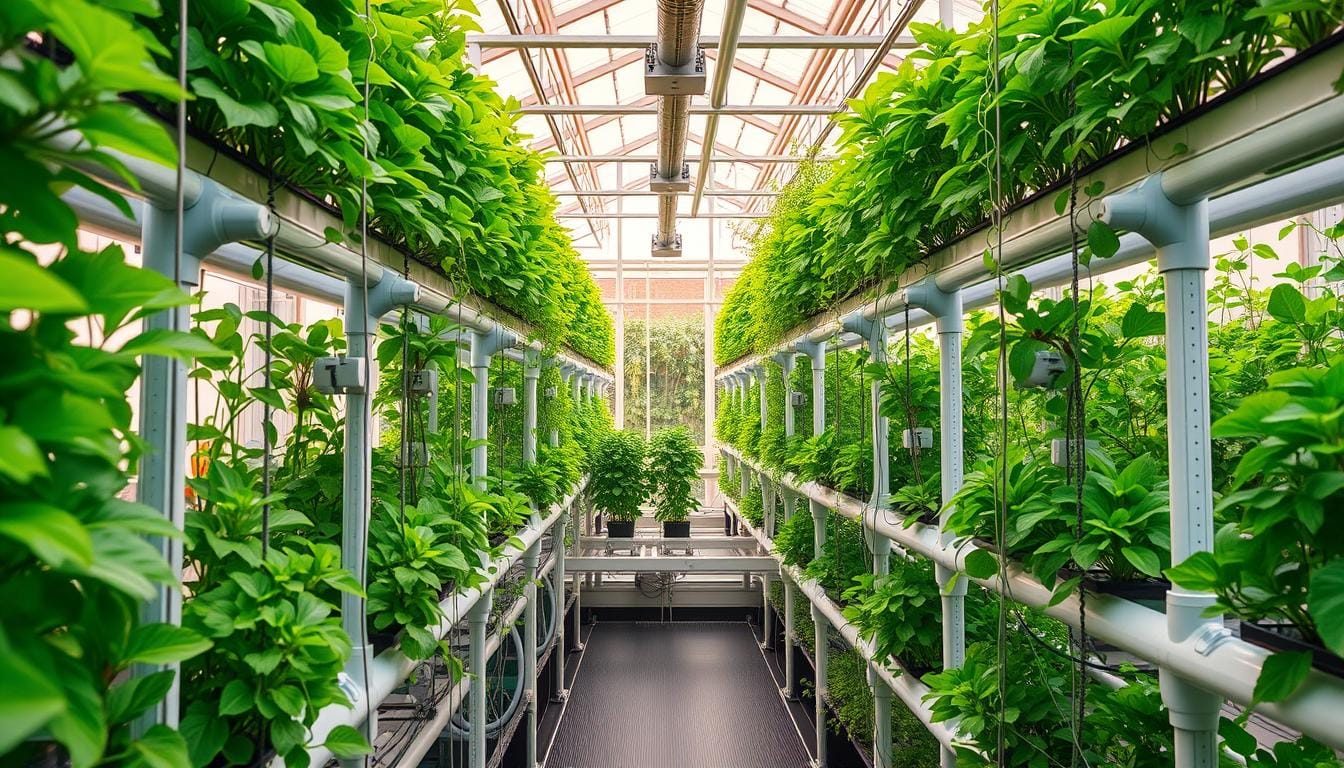Irrigation automation for hydroponic systems is changing the game for indoor gardening. By enabling efficient, precise water management, it allows us to grow food without soil and overcome the limits of traditional gardening methods. The biggest leap forward in hydroponics? It’s the automation of irrigation, which ensures plants receive the perfect amount of water at the right time, promoting faster and healthier growth.
Picture this: your plants get exactly what they need when they need it, all by themselves. Automated hydroponic systems make growing plants easy. They let you enjoy watching your plants grow without the hassle.
Key Takeaways
- Irrigation automation streamlines hydroponic gardening, offering remote control and real-time insights.
- Smart technology integrates with hydroponic systems for precise water usage monitoring and optimal growth conditions.
- Automated systems simplify tasks like nutrient management and environmental control, maximizing efficiency.
- Hydroponic farming benefits from increased yields, faster growth rates, and reduced water consumption.
- Sustainable practices like recirculating water and eliminating harmful chemicals promote eco-friendly cultivation.
Understanding Modern Hydroponic System Automation
Automating your hydroponic system brings many benefits. It can increase crop yields and use resources better. At the heart of these systems are advanced sensors and smart tech. They work together to create a self-sustaining growing space.
Core Components of Automated Systems
A modern hydroponic automation setup has key parts. These include pH sensors, EC meters, and environmental sensors like the BME280 or BME680. They monitor temperature, humidity, and gas levels. Flow sensors also track water flow in the system.
These components work together through platforms like Viam. They turn your grow room into a smart, data-driven space.
Role of Smart Technology in Hydroponics
Smart technology and IoT-enabled hydroponics are changing how growers manage their systems. These technologies handle tasks like nutrient delivery and environmental control. They also collect data in real-time, helping you make better decisions and improve your hydroponic irrigation controllers.
Integration of IoT Devices
IoT devices are key in smart grow room technology. They allow for remote monitoring and precise control of your hydroponic system. By linking sensors, actuators, and cloud platforms, you can adjust important factors like pH and temperature easily. This guarantees that your plants receive optimal growing conditions.
| Key Automation Benefits | Improvements |
|---|---|
| Crop Yield | Up to 50% increase |
| Growth Rate | Up to 50% faster |
| Water Usage | Up to 80% less than traditional agriculture |
By using automated hydroponic systems and smart tech, growers can achieve great things. They can operate with greater precision, efficiency, and sustainability. This opens up a new world of possibilities for a more successful hydroponic journey.
Water Conservation and Resource Optimization
Smart irrigation technology in hydroponics uses sensors, IoT, and advanced algorithms to save water and nutrients. The LetPot Automatic Watering System, priced at $56.49, has adjustable drippers for up to 20 plants and a 12G/H water pump. These water management solutions can cut water waste by up to 50% and offer valuable data for better decisions. They adjust watering schedules based on past evapotranspiration data, ensuring optimal water usage and healthier plant growth.
Hydroponic systems reduce water usage by as much as 90% compared to traditional farming practices. Precision irrigation scheduling through automated systems further boosts water conservation. This allows growers to deliver the right amount of water and nutrients to each plant, reducing waste and promoting faster crop growth.
Different hydroponic systems have varying water efficiency levels. For example, the Nutrient Film Technique (NFT) is very efficient, while Deep Water Culture (DWC) and Recirculating Deep Water Culture (RDWC) are moderately efficient. The most water-efficient is Aeroponics, which uses fine mist to deliver nutrients directly to the roots.
Effective water conservation techniques in hydroponics go beyond system design. Advanced features like automated irrigation controllers, IoT sensors, and filtration systems ensure water is used wisely. By tracking water levels, optimizing delivery, and recycling nutrient solutions, growers can greatly reduce their water footprint while maintaining optimal growing conditions.
“Effective water quality management, including maintaining proper pH levels and nutrient balance, is crucial for the success of hydroponic systems in maximizing water conservation.”
As the global demand for sustainable food production grows, hydroponics’ role in water management solutions becomes more critical. By integrating cutting-edge technologies, hydroponic systems are changing how we optimize water and nutrient resources. They are setting new standards for efficient and eco-friendly agriculture.
Smart Nutrient Management Through Automated Dosing
In hydroponic systems, getting nutrients right is key. Automated fertigation systems, like those from Growee, help a lot. They use high-precision pumps to give plants the nutrients they need, helping them grow better.
Precision Nutrient Delivery Systems
The Growee Smart Nutrient Doser has 2 precise pumps. This lets it send out different nutrients at the same time. You can use up to four of these dosers with each Growee Master, making it easy to adjust nutrients for different areas.
Real-time pH and EC Monitoring
Keeping the right pH and EC levels is vital for plants. Growee’s systems watch these levels closely, keeping them perfect. This is hard to do by hand, but these systems can do it with an accuracy of 0.01 pH units.
Automated Fertigation Solutions
The Growee system makes managing nutrients easy. You can control different areas from one place, making it great for big setups. It has built-in pumps and sensors, so your plants always get the right nutrients, without you having to check on them all the time.
Using nutrient dosing automation, automated fertigation, and precision agriculture helps growers a lot. It leads to healthier plants, bigger harvests, and makes growing easier and less stressful.
Environmental Control and Climate Management
Creating the perfect growing space is key for hydroponic systems to thrive. Environmental control systems use the latest tech to manage temperature, humidity, and light. These factors greatly affect plant health and growth. With automated climate control, growers can make an indoor space ideal for plants to grow well, no matter the weather.
Keeping the right temperature is crucial for hydroponic plants. Systems that heat and cool keep the perfect temperature for each plant type. For example, lettuce likes cooler temps, while tomatoes need it warmer. This smart grow room technology makes sure plants get the right warmth to grow well.
It’s also important to control humidity. Hygrometers help keep the right humidity levels, which prevents stress and diseases. Keeping humidity steady helps plants grow to their best.
Lighting systems are also key in environmental control systems. They adjust light schedules and intensity to meet plant needs. Leafy greens need less light, while tomatoes and peppers need more. This ensures plants get the right amount of light to grow strong.
With automated climate control, growers can make a perfect indoor space for their plants. These smart grow room technology tools help plants grow healthy, strong, and produce well, even when it’s bad outside.

Irrigation Automation for Hydroponic Systems
Revolutionize your hydroponic cultivation with irrigation automation. It works with Deep Water Culture (DWC), Nutrient Film Technique (NFT), or drip systems. Automated watering schedules, flow rate optimization, and pressure management systems can streamline your operations. They deliver unparalleled results.
Automated Watering Schedules
Automated watering schedules ensure your plants get the right amount of water. Smart technology manages the timing, duration, and frequency of watering automatically. This prevents water stress and promotes consistent growth.
Flow Rate Optimization
Flow rate optimization technology works with automated watering schedules. It delivers water and nutrients efficiently. By regulating flow rates, you enhance nutrient absorption and prevent waterlogging. This approach boosts crop yields and quality.
Pressure Management Systems
Precise pressure control is key for your hydroponic system’s health. Automated pressure management systems monitor and adjust pressure levels. This ensures even water distribution and proper nutrient delivery. It prevents root rot, plant stress, and uneven growth, leading to a more productive operation.
| Feature | Benefit |
|---|---|
| Automated Watering Schedules | Precise control over water delivery, ensuring optimal hydration and consistent plant growth |
| Flow Rate Optimization | Efficient water and nutrient distribution, promoting nutrient absorption and plant health |
| Pressure Management Systems | Consistent water pressure for even distribution and proper nutrient delivery |
By using these automated irrigation technologies, you can improve efficiency and crop quality. Embrace precision and let irrigation automation transform your hydroponic cultivation.
Remote Monitoring and Control Capabilities
The world of hydroponics has changed a lot with IoT technology. Now, growers can watch and control their hydroponic systems from anywhere. Advanced sensors and IoT devices give real-time data on plant health and more. This helps growers make smart choices from afar.
Growers can check their hydroponic setup’s performance with easy-to-use apps or web dashboards. This lets them quickly fix any problems, keeping the growing conditions perfect. They can adjust watering and nutrients, and even control the climate, all from their phone.
Smart technology in hydroponics is making farming better and easier. It brings more efficiency and control to growing plants. This means hydroponic farming will become even more accessible and efficient in the future.
| Feature | Benefit |
|---|---|
| Real-time monitoring of plant health, nutrient levels, and environmental conditions | Enables quick responses to issues and optimization of growing conditions |
| Remote control of watering schedules, nutrient dosing, and climate settings | Provides unparalleled flexibility and control over the hydroponic system |
| Smartphone app and web-based dashboard integration | Allows for easy, accessible management of the hydroponic setup from anywhere |
| Automated system adjustments and alerts | Reduces the need for constant on-site presence and manual interventions |

“The integration of IoT-enabled technology into hydroponics has transformed the process, enabling us to monitor and manage our grow room remotely via smartphones. It’s a true revolution in smart farming.”
– *John Doe, Hydroponic Farmer*
Enhanced Crop Yields and Quality
Automated hydroponic systems boost crop yields and quality. They control growth factors like nutrients, light, and environment. This leads to better hydroponic crop yields and harvest quality optimization.
These systems provide consistent production all year, no matter the weather. Plants grow faster and healthier. They produce more and better than those grown in soil.
Growth Rate Optimization
Advanced sensors and algorithms in automated hydroponic systems monitor and adjust growth factors. This precision optimizes growth rate. Plants grow faster and stronger.
Harvest Quality Improvements
Automated hydroponic systems keep plants in perfect conditions. This leads to harvest quality improvements. Plants have better flavor, texture, and nutrition.
Production Consistency
These systems ensure production consistency all year. They face fewer weather challenges than traditional farming. This makes them reliable and efficient.
Automation and smart technology in hydroponics have changed crop growing. Growers now get better hydroponic crop yields, harvest quality optimization, and consistent production. It also saves resources and reduces environmental impact.
| Benefits of Automated Hydroponic Systems | Conventional Soil-Based Farming |
|---|---|
| Increased crop yields and harvest quality | Variable yields and quality due to environmental factors |
| Year-round production consistency | Seasonal fluctuations in crop availability |
| Precise control over growth factors | Limited control over soil conditions and nutrient levels |
| Reduced water consumption and waste | Higher water usage and potential for runoff |
| Scalable and adaptable to evolving needs | Difficulty in expanding or adjusting traditional farming operations |
Labor and Time-Saving Benefits
Automated hydroponic systems reduce labor requirements and save farmers valuable time. Tasks like watering and nutrient management are done automatically. This enables individuals to prioritize other crucial tasks.
The design of hydroponic farms is compact. This makes tasks more efficient, leading to more productivity with fewer workers. Workers also face less risk from harmful chemicals, making their work environment safer.
Labor-saving technology in hydroponic farming makes operations smoother and more efficient. Automated systems deliver water and nutrients precisely. This means plants grow better without constant human help.
This approach saves time and cuts down on mistakes. It leads to more consistent and efficient hydroponic farming practices.
| Benefit | Statistic |
|---|---|
| Labor Cost Reduction | Hydroponic automation can reduce labor costs by automating tasks, allowing workers to focus on high-value activities. |
| Faster Plant Growth | Plants in hydroponic systems can grow up to 50% faster compared to traditional farming methods. |
| Water Efficiency | Automated hydroponic systems can save 70-90% on water consumption, leading to significant resource efficiency. |
Growers can make their farms more efficient by using automated hydroponic systems. This technology saves labor, optimizes resources, and makes work safer. It boosts farm productivity and supports efficient hydroponic farming practices. These are key for sustainable farming today.
System Integration and Scalability Options
Modern hydroponic automation systems focus on flexibility and growth. They can easily integrate with various sizes of operations. Whether you have a small urban farm or a large commercial hydroponic setup, these systems can adapt.
Vertical farming solutions are great for growing crops in cities. Scalable hydroponic systems let you start small and grow as you need. They come with integrated hydroponic solutions that can change with your needs.
The expandable automation in these systems makes them easy to grow with. They offer features like automated nutrient delivery and remote monitoring. This level of flexibility and control is new for hydroponics.
| Benefit | Description |
|---|---|
| Scalability | Hydroponic systems can be designed to accommodate future growth, with modular components that can be easily expanded or upgraded. |
| Space Optimization | Vertical farming solutions maximize available space, making them ideal for urban and indoor cultivation. |
| Customization | Integrated hydroponic solutions can be tailored to meet the specific needs of your growing operation, whether small or large. |
| Automation Integration | Seamless integration of automated systems, such as nutrient dosing and environmental controls, streamlines the growing process. |
Choosing a scalable hydroponic system with integrated hydroponic solutions and expandable automation is smart. It prepares your operation for the future. This way, your growing needs will always be met, no matter how your business grows.
Conclusion
Irrigation automation for hydroponic systems is changing farming for the better. It conserves water and resources while enhancing crop quality and increasing yield. This technology gives farmers more control and efficiency.
Smart technology and IoT devices help farmers manage nutrients and conditions better. This precision increases productivity and cuts down on waste. It makes hydroponic farming a good choice for cities and areas with limited resources.
The benefits of automated hydroponics are becoming more clear. This technology will help make farming more sustainable and secure. It’s set to play a big role in the future of agriculture, making food production more efficient and resilient.

